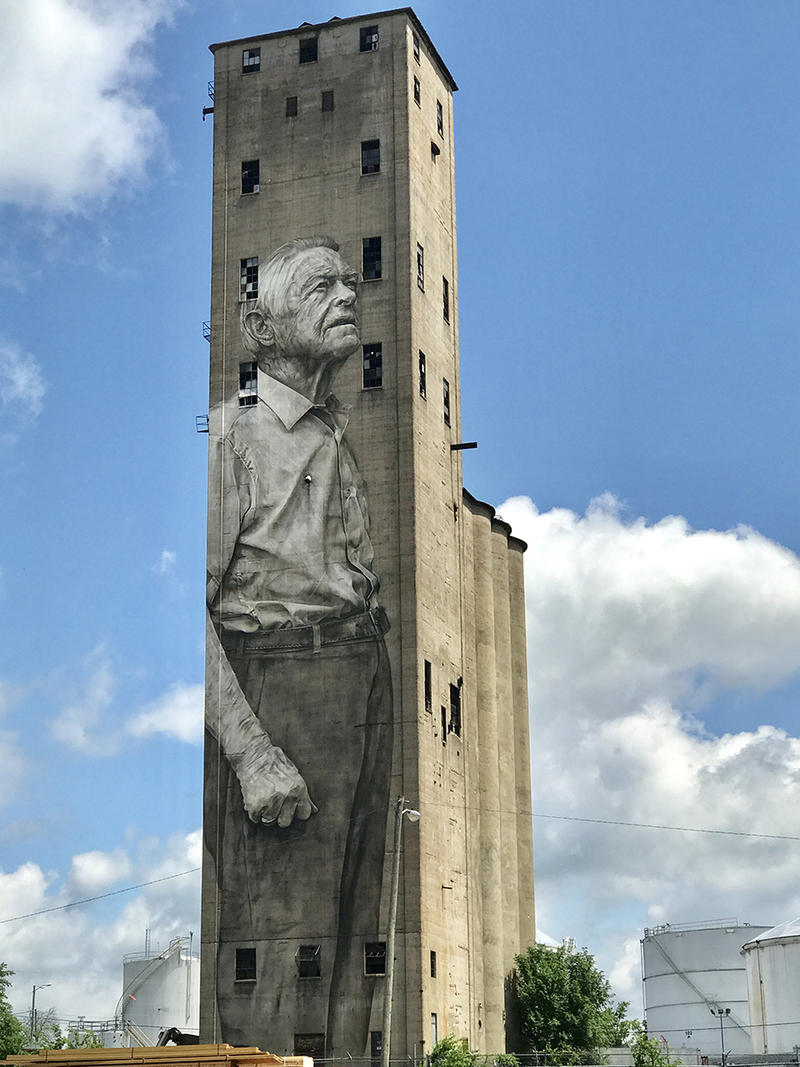
An abandoned concrete silo looms over The Nations neighborhood, eerie and empty. The historic Nashville landmark was nearly torn down. Instead, it’s becoming the centerpiece of the community’s redevelopment.
A 15-story painting is unfolding, revealing an elderly man who lived nearly all his life within sight of the silo, and neighbors are gathering at patio bars to watch as the process unfolds.
The artist is Australian Guido Van Helten, an internationally acclaimed muralist known for large-scale portraits that are so realistic they look like they could be oversized photographs. He uses a nearly black and white paint palette, allowing the gritty emotion of his subject to come through. And he likes to make a statement by painting local people.
For the Nations, Van Helten chose 91-year-old Lee Estes, known to friends as LD. He has called this neighborhood home since the late 1920s.

“It’s definitely a positive thing to commemorate people who have lived here for a long time,” Van Helten says. “You know, why do people want to live here? Part of the reason is it’s a good community, it’s got a history, people like that when they move to a place.”
Estes can certainly provide a history of the neighborhood. He says when he was growing up his family didn’t have indoor plumbing. They raised chickens for eggs and meat, milked their own cow, churned their own butter, and neighbors raised hogs. The only place for a boy to go was St. Luke’s Community House, where he played basketball and went to dances. The Nations was largely an industrial area. He remembers Nashville Hardwood and Flooring, Ingram Spinning Mill, and four fertilizer plants. He also remembers the silo.
More:
Nashville artist Brian Siskind has been filming the mural’s progress via drone.
“It used to be Gilette grainery,” he says. “And we had another, Purina grainery, that was demolished years ago, but they left this one as a historical part of the Nations.”
He’s been watching the change – houses on either side of his have been torn down for new construction, chic restaurants are opening, and young adults are moving in, finding the area more affordable than many other parts of Nashville. People constantly knock on his door offering impressive sums to buy the modest house he built in 1952.
“Now, they’re building two houses where one property was built before, and all the older neighborhood has pretty well gone out or moved other places, very few of us are left,” Estes says. “And eventually I guess they’ll get us. Hopefully I can live my lifetime where I am.
Estes spent his working years in the purchasing department at Genesco. Now he spends his days sauntering around the neighborhood, volunteering to help other seniors in craft projects at St. Luke’s, and checking in daily at a food market formerly owned by his late brother. He’s well known in the neighborhood, but his celebrity status has now skyrocketed.
“I don’t want to be famous,” he says. “I just want to be remembered.”
While Estes has a small stature, his portrait is so tall the artist had to bring in a 155-foot crane from out of state. Estes’ granddaughter Julie Bellar has been coming from her job as a hair stylist to watch her Papa become larger than life. She describes him as a quiet, unassuming man, humble in every way. “The clothes that he’s wearing in that picture are the clothes that he’s had his entire life, I’m sure,” she says.
As for his quizzical expression in the mural, Bellar guesses her Papa is “Probably confused as to why they picked him!”
“Never in his life did he think that he would get any type of recognition like that. So, it’s amazing.” Staring up at the mural, she says, “That’s my Papa, forever.”
He can see the monumental mural from his driveway, and it makes him laugh. “I’ll just glance over and say hello!” he says.
A 91-year-old in a short-sleeve button-down and high-waisted slacks could be seen as an odd choice to represent a hip, up-and-coming neighborhood. But the image is meant to implore newcomers to respect the past. Lee Ann Merrick, who opened her Tin Wings food shop here three years ago, says there is occasional tension between long-time residents and newbies. Shared public art eases the tension and brings people together, she says.
“Right now that’s exactly what’s happening,” she says during a watch party on the patio of The Old Gas Station bar. “Everybody’s coming together. And I’m hoping that I can talk my landlord into a mural project on the side of our building.”
There will be more art to come – Councilwoman Mary Carolyn Roberts is planning an entire arts district. The centerpiece, though, will always be the towering silo. When the mural is complete, Lee Estes will be joined by two young boys from the neighborhood, the artist’s nod to the future.


